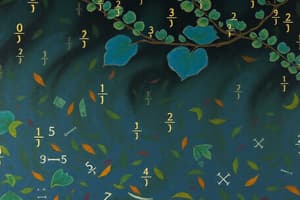Podcast
Questions and Answers
What does the numerator represent in a fraction?
What does the numerator represent in a fraction?
- The value of each part
- The size of the whole
- The total number of parts
- The number of equal parts being considered (correct)
Which term is used to describe fractions that may look different but express the same value?
Which term is used to describe fractions that may look different but express the same value?
- Disparate fractions
- Distinct fractions
- Equivalent fractions (correct)
- Unique fractions
What must be done to find equivalent fractions?
What must be done to find equivalent fractions?
- Multiply only the numerator by a nonzero integer
- Multiply both the numerator and denominator by the same nonzero integer (correct)
- Multiply only the denominator by a nonzero integer
- Divide the numerator by the denominator
In which operation are you likely to encounter a common denominator when working with fractions?
In which operation are you likely to encounter a common denominator when working with fractions?
What is compared when comparing fractions?
What is compared when comparing fractions?
When adding fractions with different denominators, what is the first step to take?
When adding fractions with different denominators, what is the first step to take?
In subtracting fractions with the same denominator, what operation should be applied to one of the fractions?
In subtracting fractions with the same denominator, what operation should be applied to one of the fractions?
To compare fractions easily, what should be done if the denominators differ?
To compare fractions easily, what should be done if the denominators differ?
What is the correct process for subtracting fractions when they have different denominators?
What is the correct process for subtracting fractions when they have different denominators?
When comparing fractions, why is it important to find the greatest common divisor (GCD) of the denominators?
When comparing fractions, why is it important to find the greatest common divisor (GCD) of the denominators?
Flashcards are hidden until you start studying
Study Notes
Exploring Fractions
Fractions are a fundamental part of mathematics that help us represent portions or parts of a whole. They allow us to deal with quantities more finely divided than just integers. Let's delve into this crucial concept by examining its key facets—introduction to fractions, equivalent fractions, adding fractions, subtracting fractions, and comparing them.
Understanding Fractions
A fraction is made up of two numbers separated by a horizontal line called the bar or vinculum. For example ( \frac{3}{5} ) represents three fifths of something, where ( 3 ) is known as the numerator and ( 5 ) is the denominator. A fraction tells you how many equal parts out of the total number denoted by the denominator make up the given portion specified by the numerator.
Equivalent Fractions
Two different-looking fractions can still express the same value if they have the same numerical worth. These are referred to as equivalent fractions, like ( \frac{1}{3} ), ( \frac{2}{6} ) (or simply ( \frac{1}{2} )), and ( \frac{3}{9} ) (which we also recognize as ( \frac{1}{3} )). To find equivalent fractions, one must multiply both the numerator and denominator by the same nonzero integer, while ensuring that both values remain positive when dividing the original numerators and denominators.
For instance, ( \frac{1}{2} = \frac{5}{10}= \frac{3}{6}= \ldots), since they all result from multiplying either the top or bottom by ( 2,\ 5,\ 3 ), respectively. In each case, these operations maintain the ratio between the numerator and denominator, yielding mathematically identical results.
Adding Fractions
When adding fractions having the same denominator, the process is straightforward. One merely adds their corresponding numerators without altering the common denominator. If the denominators differ, first convert those fractions to a common denominator before performing addition. This step involves finding equivalent fractions.
Suppose we wish to combine ( \frac{2}{3}+\frac{1}{4}=\frac{8+3}{12} =\frac{11}{12}). First, identify the least common multiple (LCM) of the two denominators ((3\times 4=12)). Then rewrite the second fraction using equivalence: ( \frac{1}{4} = \frac{3}{12} ). Next, sum the new numerators (in this case ( \frac{2+3}{12} )). Lastly, reduce the resulting expression, if possible ((\frac{5}{12}\rightarrow\frac{11}{12})).
Subtracting Fractions
Subtraction follows similar principles to addition, though some adjustments might need to be made based on whether the denominators are alike or unlike. When dealing with unlike denominators, proceed as described above for adding them. However, when subtracting fractions sharing the same denominator, change one of the operands to its opposite (i.e., ( -\text{operand} )) before applying the rule mentioned earlier.
To illustrate: ( \frac{4}{7}-\frac{1}{7}=\frac{4}{7}- \underbrace{\frac{-1}{7}}_{\frac{7(-1)}{7}})=(\frac{4+1}{7}=\frac{5}{7})
Comparing Fractions
Comparisons involve determining which of two fractions has a larger or smaller value. As with addition and subtraction, fractions may either have the same or distinct denominators. By locating the greatest common divisor (GCD) among the denominators (( GCD(x,y) ) ) and converting any higher denominators to lower ones through division, we simplify comparison tasks.
If the GCD appears only once within the denominators, compare the ratios directly; otherwise, divide both the numerators and denominators by the GCD before making the comparison. With this methodology, it becomes easier to ascertain relationships such as ( \frac{3}{4}>\frac{1}{2} > \frac{1}{3} ).
Studying That Suits You
Use AI to generate personalized quizzes and flashcards to suit your learning preferences.




